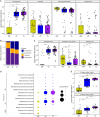Effect of single versus multistrain probiotic in extremely preterm infants: a randomised trial
- PMID: 35185013
- PMCID: PMC8860036
- DOI: 10.1136/bmjgast-2021-000811
Effect of single versus multistrain probiotic in extremely preterm infants: a randomised trial
Abstract
Objective: Evidence indicates that multistrain probiotics benefit preterm infants more than single-strain (SS) probiotics. We assessed the effects of SS versus triple-strain (TS) probiotic supplementation (PS) in extremely preterm (EP) infants.
Design: EP infants (gestational age (GA) <28 weeks) were randomly allocated to TS or SS probiotic, assuring blinding. Reference (REF) group was EP infants in the placebo arm of our previous probiotic trial. PS was commenced with feeds and continued until 37 weeks' corrected GA. Primary outcome was time to full feed (TFF: 150 mL/kg/day). Secondary outcomes included short-chain fatty acids and faecal microbiota collected at T1 (first week) and T2 (after 3 weeks of PS) using 16S ribosomal RNA gene sequencing.
Results: 173 EP (SS: 86, TS: 87) neonates with similar GA and birth weight (BW) were randomised. Median TFF was comparable (11 (IQR 8-16) vs 10 (IQR 8-16) days, p=0.92). Faecal propionate (SS, p<0.001, and TS, p=0.0009) and butyrate levels (TS, p=0.029) were significantly raised in T2 versus T1 samples. Secondary clinical outcomes were comparable. At T2, alpha diversity was comparable (p>0.05) between groups, whereas beta-diversity analysis revealed significant differences between PS and REF groups (both p=0.001). Actinobacteria were higher (both p<0.01), and Proteobacteria, Firmicutes and Bacteroidetes were lower in PS versus REF. Gammaproteobacteria, Clostridia and Negativicutes were lower in both PS versus REF.
Conclusion: TFF in EP infants was similar between SS and TS probiotics. Both probiotics were effective in reducing dysbiosis (higher bifidobacteria and lower Gammaproteobacteria). Long-term significance of increased propionate and butyrate needs further studies.
Trial registration number: ACTRN 12615000940572.
Keywords: infant/neonatal nutrition; intestinal microbiology; neonatal gut; probiotics.
© Author(s) (or their employer(s)) 2022. Re-use permitted under CC BY-NC. No commercial re-use. See rights and permissions. Published by BMJ.
Conflict of interest statement
Competing interests: None declared.
Figures




Similar articles
-
Effects of a live versus heat-inactivated probiotic Bifidobacterium spp in preterm infants: a randomised clinical trial.Arch Dis Child Fetal Neonatal Ed. 2025 Feb 21;110(2):177-184. doi: 10.1136/archdischild-2023-326667. Arch Dis Child Fetal Neonatal Ed. 2025. PMID: 39153842 Clinical Trial.
-
Bifidobacterium and Lactobacillus Probiotics and Gut Dysbiosis in Preterm Infants: The PRIMAL Randomized Clinical Trial.JAMA Pediatr. 2024 Oct 1;178(10):985-995. doi: 10.1001/jamapediatrics.2024.2626. JAMA Pediatr. 2024. PMID: 39102225 Clinical Trial.
-
Effect of Bifidobacterium breve M-16V supplementation on faecal bifidobacteria in growth restricted very preterm infants - analysis from a randomised trial.J Matern Fetal Neonatal Med. 2016 Dec;29(23):3751-5. doi: 10.3109/14767058.2016.1147554. Epub 2016 Feb 26. J Matern Fetal Neonatal Med. 2016. PMID: 26821074 Clinical Trial.
-
A meta-analysis of probiotics for preventing necrotizing enterocolitis in preterm neonates.Braz J Med Biol Res. 2014 Sep;47(9):804-10. doi: 10.1590/1414-431x20143857. Epub 2014 Aug 1. Braz J Med Biol Res. 2014. PMID: 25098619 Free PMC article. Review.
-
Probiotics reduce the risk of necrotizing enterocolitis in preterm infants: a meta-analysis.Neonatology. 2010;97(2):93-9. doi: 10.1159/000235684. Epub 2009 Aug 25. Neonatology. 2010. PMID: 19707025 Review.
Cited by
-
Microbial regulation of offspring diseases mediated by maternal-associated microbial metabolites.Front Microbiol. 2022 Nov 4;13:955297. doi: 10.3389/fmicb.2022.955297. eCollection 2022. Front Microbiol. 2022. PMID: 36406399 Free PMC article. Review.
-
Microbiome-targeting therapies in the neonatal intensive care unit: safety and efficacy.Gut Microbes. 2023 Jan-Dec;15(1):2221758. doi: 10.1080/19490976.2023.2221758. Gut Microbes. 2023. PMID: 37358104 Free PMC article. Review.
-
Probiotics in the New Era of Human Milk Oligosaccharides (HMOs): HMO Utilization and Beneficial Effects of Bifidobacterium longum subsp. infantis M-63 on Infant Health.Microorganisms. 2024 May 17;12(5):1014. doi: 10.3390/microorganisms12051014. Microorganisms. 2024. PMID: 38792843 Free PMC article. Review.
-
Deciphering dynamic antibiotics-microbiome-metabolome interactions in preterm infants using systems biology.iScience. 2025 Jun 28;28(8):113038. doi: 10.1016/j.isci.2025.113038. eCollection 2025 Aug 15. iScience. 2025. PMID: 40703452 Free PMC article.
-
Probiotics to improve the gut microbiome in premature infants: are we there yet?Gut Microbes. 2023 Jan-Dec;15(1):2201160. doi: 10.1080/19490976.2023.2201160. Gut Microbes. 2023. PMID: 37122152 Free PMC article. Review.
References
Publication types
MeSH terms
Substances
LinkOut - more resources
Full Text Sources
